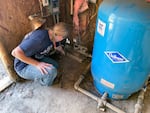A Columbia River port has agreed to address groundwater pollution by spending $200 million on wastewater treatment and other water quality improvements.
The Port of Morrow announced Friday that its new round of spending was meant to bring it into compliance with the requirements of a modified permit issued by the Oregon Department of Environmental Quality. The DEQ had fined the port for repeated wastewater violations that led to hundreds of tons of excess nitrates seeping into the groundwater in the region.

Port of Morrow's East Beach Facility in Boardman, Oregon on April 15, 2022.
Monica Samayoa / OPB
Under the permit modification, the port will no longer be able to apply nitrogen-rich wastewater onto nearby farmland during winter months. That wastewater comes primarily from food processors, storage facilities and data centers
The Residents of Morrow and Umatilla counties rely on groundwater as their main source of drinking water. Nitrate pollution has made that water unsafe.
“Even though the port is responsible for approximately 3.5% of the nitrates found in the Lower Umatilla Groundwater Management Basin, our responsibility as environmental stewards is to do everything possible to ensure industrial wastewater remains a community asset,” Port Executive Director Lisa Mittelsdorf said in a statement attached to the press release.
Mittelsdorf did not return a call requesting comment. Rick Stokoe, the president of the port commission, said he couldn’t comment while working his day job as the police chief of Boardman and referred questions to port staff.
The port’s water quality permit allows it to collect nitrogen-rich wastewater to use in irrigation on nearby farms. Nitrogen is a beneficial plant nutrient when used in appropriate amounts. But excess amounts can lead to high levels of nitrate, which can seep into the soil and groundwater.
Drinking high levels of nitrate can cause health risks, including respiratory infections and stomach or bladder cancer. According to the Environmental Protection Agency, nitrate levels exceeding 10 milligrams per liter can cause serious health effects.

Annie Philpott says her families private well needs to be replaced but do not have the money to replace it. The Philpott's were hoping to refinancr their home but did not qualify after their well system tested too high for nitrates.
Monica Samayoa / OPB
Earlier this year, DEQ issued its second-largest fine ever to the port for repeated wastewater application which led to an estimated 261 tons of excess nitrate in the groundwater. The agency said the port violated its permit more than two thousand times between 2018 to 2021. The port filed to appeal the penalty, claiming the violations were “unintentional” and were a result of things that were out of the port’s control.
In a press release, the port said that its commissioners declined to appeal the permit despite concerns over DEQ’s “aggressive timelines” and how the agency calculated nitrogen levels.
In 2015, DEQ fined the port nearly $300,000 for exceeding its permitted nitrogen limits. The agency and the port settled the case for $129,000 along with a corrective action schedule that limited the amount of nitrate used on nearby farmland from November through February. The port violated these conditions, which led to the hefty fines in 2022.
Kristin Ostrom has helped test home drinking water systems for nitrates in Morrow County through her organization, Oregon Rural Action, and sits on the Lower Umatilla Basin Groundwater Management Area committee as a community representative. She said DEQ needs to focus more of its efforts on nearby communities.
“DEQ is responsive to the needs of the Port of Morrow,” she said. “When are they going to respond to the needs of the community, who are without access to safe drinking water?”
The port laid out a timeline for its planned improvements: the installation and activation of three new aerobic digesters to treat high-nutrient wastewater by November 2023, the building of oxidation ditches to provide secondary treatment by July 2025, and the construction of new wastewater storage lagoons by November 2026.
The port plans to return to the state to request funding for these projects, in addition to submitting grant applications to the EPA. But the port also hedged on its timeline, pointing to potential “supply chain issues” that could push back the construction schedule further.